


Ask any 1950s schoolboy, or anyone interested in aviation history or travel what the first jet airliner was and they will correctly tell you the de Havilland Comet. Ask them what the second one to fly was and you would no doubt get varied answers such as the Boeing 707, Douglas DC-8, the Sud Aviation Caravelle or maybe a long shot the Convair Cv-880. Almost nobody would correctly say the Avro Canada C102. This aeroplane first flew in Canada on 10 August 1949 just two weeks after the UK Comet, so why do we know so little about it? This is the story of those early jets that led to the demise of the piston engine fleets the world’s airlines had been operating up until the 1950s.

First out of the blocks as those schoolboys have told us was the Comet 1. First flying on 27 July 1949 the revolutionary jet powered airliner first entered service with BOAC in May 1952. No other manufacturer was anywhere near putting a jet airliner into service, indeed the next jet to enter service would not do so until 1956. It looked as if de Havilland would mop up the sales with orders coming in from around the world. Sadly as is well known, after a number of unexplained fatal crashes the Comets were all grounded in April 1954. After an investigation found the cause of the crashes to be metal fatigue de Havilland modified all the Comets already on the production line and sold them to the RAF. The next civilian version to fly was the much modified and larger Comet 4, a true transatlantic airliner which entered service with BOAC in 1958. In the interim other manufacturers looked at the problems the Comet had encountered and modified their own designs accordingly.
The lead de Havilland once had was gone. Our own Comet 4 G-APDB and sister ship PDA did however just manage to keep their noses ahead when they beat the Boeing 707 to be the first jet airliners to cross the Atlantic in October 1958.

The Comet was the first jet airliner to fly and also the first to enter airline service, so which type was second? The second jet airliner to fly was the Avro Canada C102 on 10 August 1949 flying from the factory in Toronto Canada, just two weeks after the Comet first took off from Hatfield. Looking quite similar in appearance to Avro’s Tudor 8 - a jet powered Tudor test aircraft, the C102 was designed originally to have just two Avon engines as its powerplants. Rolls Royce however was facing delays in the development of the Avon and reluctantly told Avro Canada the engines would not be available by the time the C102 was ready to fly. Because of this the design was altered to have four Rolls Royce Derwents instead. The new airliner was designed in close co- operation with Trans Canada Airlines (later to become Air Canada) who were interested in buying a number of the jet airliners which would make them the first airline in Canada or the US to operate jets. Howard Hughes of Trans World Airlines (TWA) was also taking an interest in the design with a planned order for 30 of the new jet powered aeroplanes.

TCA kept changing its requirements and by the time the prototype had flown were still to place an order. The prototype became the first jet airliner to carry airmail when it flew from Toronto to New York in April 1950. A second prototype was being constructed but with Avro Canada also making the CF-100 Canuck jet fighter for the RCAF. This had led to delays in production of both aircraft. Eventually in 1951 the Canadian government desperate to get their fleet of CF-100s and with no firm orders for the C102, ordered Avro Canada to stop all work on the airliner. Howard Hughes at TWA was still keen to get his hands on the jet and even entered into talks with US company Convair to build them under licence, the Canadian government however would not allow the airliner to be built outside Canada so the project was scrapped along with the prototypes.
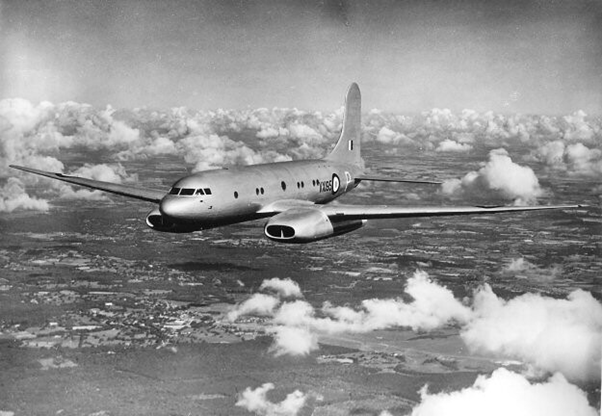
If the C102 was the second airliner to fly but didn’t enter production who was next in line to be the second to enter service after the Comet? Boeing had flown its 367-8 in July 1954 and this would be developed into the well known Boeing 707 but that wouldn’t enter service until 1958 just days after the Comet first crossed the Atlantic. So maybe second in service was Douglas or Convair in the US or even the Caravelle back on this side of the Atlantic in France? In fact we have to look further east for the second jet airliner in service. As far east as Russia and the Tupolev factory. Andrei Tupolev’s first jet airliner the Tu-104 had first flown in June 1955 just a month after the Caravelle however the French aeroplane was not to enter service for another four years. The Tu-104 began flying on scheduled service with Aeroflot in September 1956. With the Comet grounded the Tu-104 was the only jet airliner flying in the world between 1956-1958
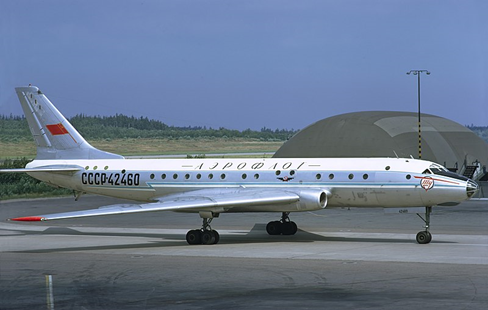
Based on the Tu-16 Badger bomber the Tu-104 was designed to carry 50 passengers and Aeroflot, the world’s largest airline at time went on to operate the majority of the 201 built. Others were operated by the Russian and Mongolian Air Forces. The only other airline to operate the Tu-104 was CSA of Czechoslovakia who bought six examples configured to carry 81 passengers. Just like the Comet the Tu-104 suffered a number of crashes, but unlike the Comet the Russian authorities never grounded the type. After another crash in 1979 Aeroflot finally retired the type from its fleet but several flew on with the military. The last ever flight was a delivery to a museum in 1986. Lessons learned from the Tu-104 were put to good use with the much more reliable and successful Tu-134 and Tu-154 that sold to most Soviet eastern bloc countries and beyond and of course the world’s first supersonic airliner the Tu-144.
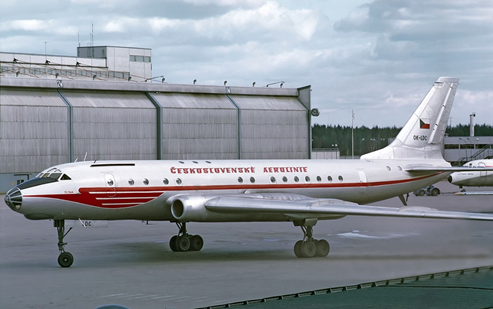
In 1957, with the Avro Canada C102 having been cancelled in 1951, the Caravelle prototype flying, the Comet grounded and just the Tu-104 in service, Boeing launched its Boeing 707, developed from the proof of concept 367-80 which had originally been planned as a tanker for the USAF. The 707 took to the skies in December 1957.This was the American’s first jet airliner but was the fifth type to take to the skies. They were beaten by beaten by the Canadian, British, Russian and French aeroplanes. It would however go on to be the most commercially successful having learned from all the early jet airliner problems from those who went before. Boeing had originally planned to make the cabin wide enough for five abreast seating, but several airlines had suggested it matched their competitor the Douglas DC-8 with six abreast. Boeing accepted this decision and widened the fuselage to suit.
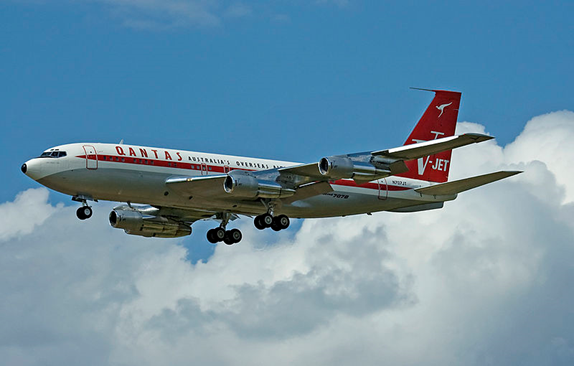
Pan American were to be the launch customer for the new Boeing jet and it entered service on 26 October 1958 just days after the new Comet 4 had been delivered to BOAC and made that first jet airliner flight across the Atlantic. Many variants of the 707 would be built from the 865 examples that left the Seattle production line and it’s fair to say it was the Boeing that introduced most of the world to the jet age. BOAC who had stuck with the Comet eventually replaced them with a fleet of 707s as the Boeing was much more commercially attractive. As time went by the 707 was replaced in passenger service by another Boeing product the 747 but many of the jets were converted to freighters. Thankfully with the wider than originally planned fuselage the cabin could accept standard size freight containers loaded through a large door on the forward fuselage side.
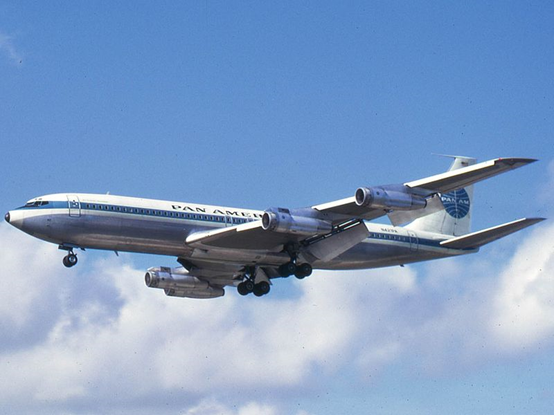
Further down the US west coast at Long Beach California, Boeing’s greatest rival Douglas had not been slow to offer a jet design with its DC-8. Based on the same four-engine layout as the 707, the Douglas jet first flew in May 1958 a few months before the Boeing entered service. The first variant of the DC-8 was 150 feet long and could carry 177 passengers and entered service with United and Delta airlines in September 1959. Various different versions were offered all with the same fuselage but different engine and range options. In 1960 Douglas offered a new longer fuselage version the DC-8 60 series which could now carry 259 passengers - a 37 feet stretch to 187 feet long. There was also a long-range version with a less extreme stretch of just seven feet from the original DC-8 giving seating for 189. At the time the long fuselage DC-8 61/63 versions were the largest airliners in the world.
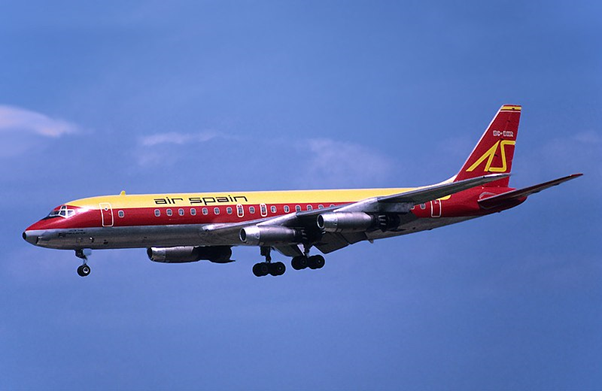
From the outset of DC-8 production Douglas had been able to offer a freight version due to the fact the fuselage had been originally designed wide enough to accommodate standard freight containers. As well as new builds many ex-passenger aircraft were converted into freighters. Production of the DC-8 ended in1972 with 556 examples having been built, but this was not the end of the first jet airliner from Douglas by a long means. In 1975 there was a proposal to re-engine the 60 series aircraft with new fuel efficient CFM-56 by-pass fan engines. This modification was fitted to 110 of the -60 aeroplanes which became -70 aeroplanes. The overnight small parcel freight companies such as UPS, Emery, Burlington etc became big operators. Some still fly the DC-8 -70 series today.
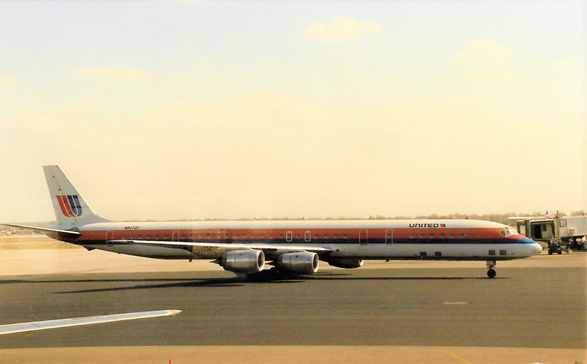
The DC-8 had entered service just after the Caravelle started operations in Europe with SAS. Having flown first back in 1955 its long gestation period finally saw the Caravelle carrying passengers in April 1959. Built by Sud-Aviation at Toulouse in France the Caravelle soon became the European airlines’ jet of choice with most of the west European airlines operating them on their short to medium haul routes. Featuring the same nose section as the Comet and Rolls Royce Avon engines the early versions had a lot of UK components in them. 282 of these elegant airliners would be produced with the later aircraft having more modern Pratt and Whitney engines fitted.
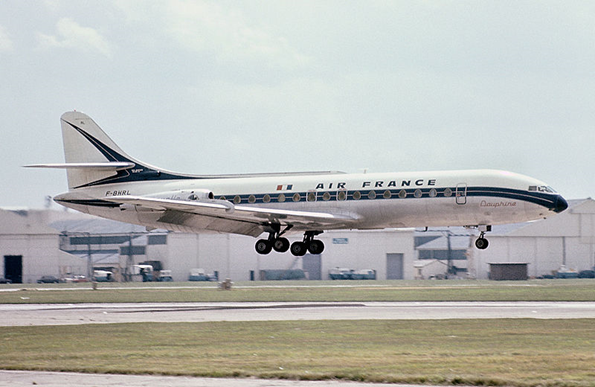
So well liked were the Caravelles that when the major airlines replaced them with more modern equipment there was a ready market for them with the secondary airlines around the world. The last Caravelle was finally retired in 2005. Sud-Aviation were looking at a supersonic successor to the Caravelle to be called the Super-Caravelle. As history shows however, when they entered into partnership with the British Aircraft Corporation this joint supersonic airliner would be named Concorde. When the Caravelle first flew in 1955 it was the only jet airliner designed specifically for short/medium range routes.
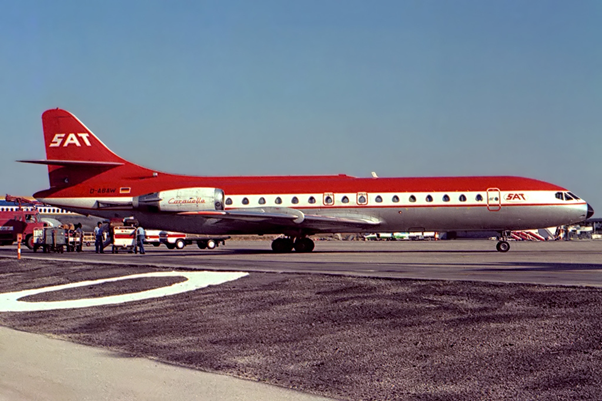
There was just one other manufacturer which joined the first generation jet airliner race and that was the US company Convair. famed for making military fighters and bombers as well as the highly successful twin piston engine Cv-240/340/440 range of airliners. The company first flew its medium range Cv-880 jet in January 1959. With the same engine layout as the Boeing and Douglas designs the Cv-880 was a narrower, smaller and hence faster airliner than its two US rivals. In 1961 at the request of American Airlines Convair stretched the Cv-880 to enable 121 instead of 110 seats to be fitted and also increased its range and speed. It was designed to be able to fly non- stop across the USA. However its passenger load was still less than that of the Boeing or Douglas offerings but it was around 35mph faster in the cruise. Even with large fairings on the wings to reduce drag the Cv-990 still struggled to cross the US non -stop. As a result American Airlines started to retire the type in 1967. The new larger variant was named the Cv-990 and it and its smaller brother the 880 were both assembled at the Convair works at San Diego California.
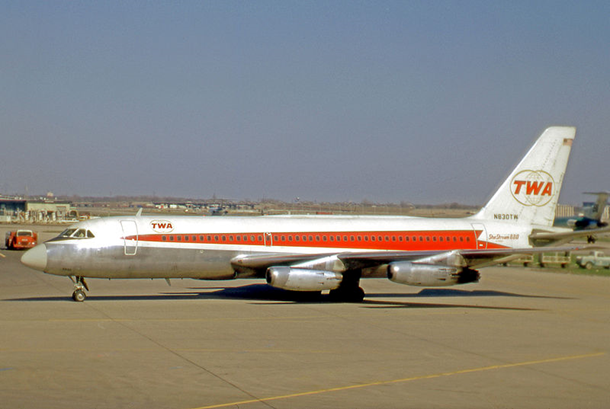
It was Delta Airlines who in 1960 were first to put the Cv-880 into service. This would be the last of the first generation jets to enter service. Other airlines to use the 65 aeroplanes built were Cathay Pacific, Japan Airlines, Northeast, Viasa, Swissair and the biggest operator of the type TWA. Elvis Presley also used one as his private jet and this is preserved across the road from his home at Gracelands, Memphis. With one other exception all the Cv-880 fleet were scrapped by 2000. As well as American, Alaska and Northeast in the USA, the bigger and faster Cv-990 saw service in Europe with Swissair, Spantax and SAS. Swissair naming theirs ‘Coronados’ . The Cv-990 used a civilianised version of the Pratt & Whitney J79 which was characterised by the huge black smoke trails Cv-990s always left in their wake, they were also very fuel-thirsty engines. Only 37 Cv-990s would be built and its narrow five- abreast seating fuselage prevented them from being converted to freighters after the airlines sold them on, so most were eventually parked in the desert and scrapped. The last operator of a Cv-990 was NASA who finally retired their one example in 1994. Convair’s foray into the jet airliner market had been a failure and as such the company never made another airliner concentrating solely on the military side of the business.
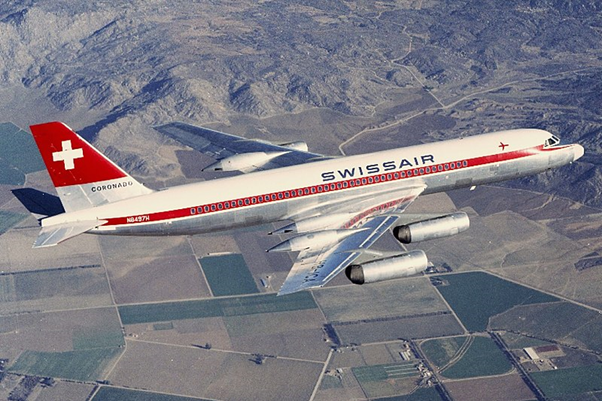
To sum up the early jetliner race let’s take a look at the results.
First jet airliner to fly: de Havilland Comet 1, 27 July 1949
Second jet airliner to fly: Avro-Canada C102, 10 August 1949
Third Jet airliner to fly: Sud-Aviation Se210 Caravelle 27 May 1955
First to enter service: de Havilland Comet 1, 2 May 1952
Second to enter service: Tupolev Tu-104 ,15 September 1956
Third to enter service: de Havilland Comet 4, 4 October 1958
Of the seven companies involved only two, Boeing and Tupolev, still make airliners under their original name. But it’s thanks to all these companies that today we have a thriving and safe jet airliner industry.
‘till the next time Keith
Registered Charity No. 285809